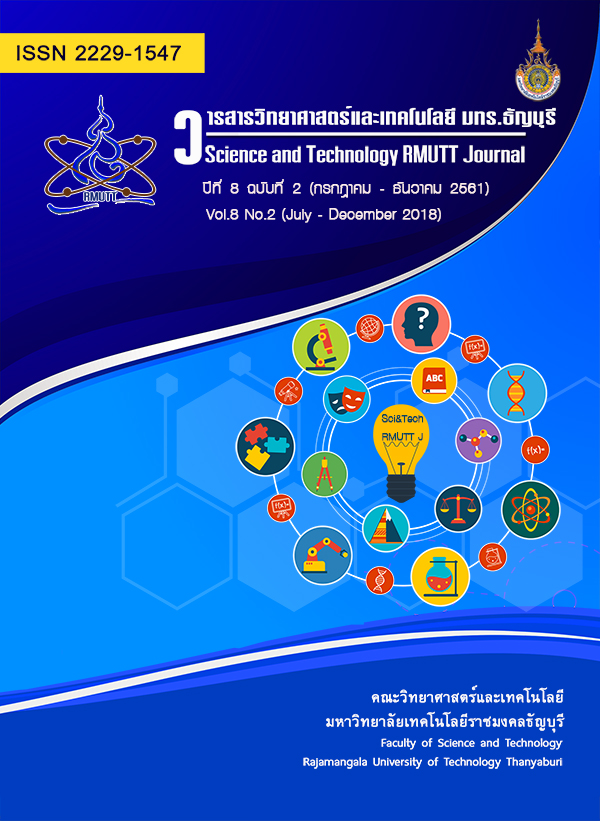Study the utilization of waste water from the coagulation of raw rubber sheet for rubber cup lump coagulation
Main Article Content
Abstract
This research aimed to study the utilization of waste water from the coagulation of raw rubber sheet in rubber cup lump coagulation. The acidity levels of waste water are low for use as the coagulating agent into rubber cup lump. The quality amount of waste water and the mixing ratio between formic acid/wastewater were studied to compare properties of rubber cup lumps from the coagulation of waste water with formic acid. The study found that the wastewater can coagulate rubber cup lumps best waste water content at 50 ml to coagulation a rubber cup lump for 5 h. The ratio of formic acid/waste water to coagulate rubber cup lumps as quickly and completely as possible was 50:50, the amount of formic acid/waste water volume of 15-30 ml that can coagulate rubber cup lumps for 35 minutes. The color of the rubber cup lump had a light brown color, similar to the rubber cup lump coagulation with formic acid. Moreover, the properties of rubber cup lump coagulation by formic acid/wastewater are the same properties as the Standard Thai Rubber from rubber cup lump coagulation with formic acid.
Article Details
References
สำนักงานตลาดกลางยางพาราหนองคาย. ยางก้อนถ้วย. [เข้าถึงเมื่อ 25 มิถุนายน 2559] เข้าถึงได้จาก https://goo.gl/NGFoNP.
ศูนย์วิจัยและพัฒนาการเกษตรสงขลา. การผลิตยางก้อนถ้วย. [เข้าถึงเมื่อ 25 มิถุนายน 2559] เข้าถึงได้จาก https://goo.gl/9ZVseK.
ปรีดิ์เปรม ทัศนกุล. หยุดการใช้กรดซัลฟิวริกในการจับตัวยาง. วารสารยางพารา. 2558. 36(3) : 14-18.
ปรีดิ์เปรม ทัศนกุล. ผลเสียของการใช้น้ำหมักชีวภาพและน้ำส้มควันไม้ในการจับตัวยาง, วารสารยางพารา. 2555. 33(2) : 2-18
Nhu Hien N. and Thanh Tha L. Situation of wastewater treatment of natural rubber latex processing in the Southeastern region. Journal of Vietnamese Environment. 2012. 2(2) : 58-64.
Tekasakul P. and Tekasakul S. Environmental problems related to natural rubber production in Thailand. Journal of Aerosol Research. 2006. 21(2) : 122-129.
Edirisinghe J.C. Community pressure and environmental compliance: case of rubber processing in Sri Lanka. Journal of Environmental Professionals Sri Lanka. 2012. 1(1) : 14-23.
Momodu O., Ekundayo A.O., Ogiehor I.S., Iyayi A.F., Ohaga S. and Momoh D. Pollution monitoring and control in rubber industry in Nigeria. Direct Research Journal of Agriculture and Food Science. 2017. 5(7) : 278-283.
กรมควบคุมมลพิษกระทรวง ทรัพยากร ธรรมชาติและสิ่งแวดล้อม. แนวปฏิบัติที่ดีด้านการป้องกันและลดมลพิษ อุตสาหกรรมยางแผ่นรมควัน. กรุงเทพฯ: ม.ป.ท.; 2548.
ประกาศกระทรวงวิทยาศาสตร์ เทคโนโลยีและสิ่งแวดล้อม ฉบับที่ 3 พ.ศ. 2539 เรื่องกำหนดมาตรฐานการระบายน้ำทิ้งแหล่งกำเนิดประเภทอุสาหกรรมและนิคงอุสาหกรรม; 2539
ก๊าซชีวภาพ (Biogas). [เข้าถึงเมื่อ 3 เมษายน 2560] เข้าถึงได้จาก http://www.siamchemi.com.
Sakdapipanich J. and Insom K. High-resolution gas chromatography-mass spectrometry-Characterization and mechanism to generate the obnoxious odor in natural rubber. KGK rubberpoint. 2006. 59(7-8). 382-387.
ปรีดิ์เปรม ทัศนกุล. ปัจจัยที่ใช้ในการควบคุมคุณภาพยางแท่งจากยางแห้ง. วารสารยางพารา. 2557. 35(2) : 15-25.


